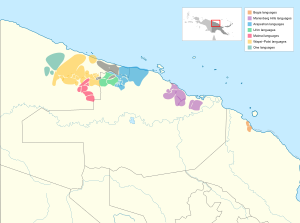
The Torricelli languages are a family of about fifty languages of the northern Papua New Guinea coast, spoken by about 80,000 people. They are named after the Torricelli Mountains. The most populous and best known Torricelli language is Arapesh, with about 30,000 speakers.
The Left May or Arai languages are a small language family of half a dozen closely related but not mutually intelligible languages in the centre of New Guinea, in the watershed of the Left May River. There are only about 2,000 speakers in all. Foley (2018) classifies them separately as an independent language family, while Usher (2020) links them with the Amto–Musan languages.
The Yuat languages are an independent family of five Papuan languages spoken along the Yuat River in East Sepik Province, Papua New Guinea. They are an independent family in the classification of Malcolm Ross, but are included in Stephen Wurm's Sepik–Ramu proposal. However, Foley and Ross could find no lexical or morphological evidence that they are related to the Sepik or Ramu languages.
Amal is a language spoken along the border of Sandaun Province and East Sepik Province, Papua New Guinea, along the Wagana River near the confluence with Wanibe Creek. Foley (2018) classifies Amal as a primary branch of the Sepik languages, though it is quite close to Kalou.

The Sepik Hill languages form the largest and most ramified branch of the Sepik languages of northern Papua New Guinea. They are spoken along the southern margin of the Sepik floodplain in the foothills of Central Range of south-central East Sepik Province.

The Palei languages constitute a branch of the Torricelli language family according to Laycock (1975). They are spoken in mountainous regions of eastern Sandaun Province, Papua New Guinea.

The Wapei languages constitute a branch of the Torricelli language family according to Laycock (1975). Glottolog does not accept this grouping. They are spoken in mountainous regions of eastern Sandaun Province, Papua New Guinea.

The Tama languages are a small family of three clusters of closely related languages of northern Papua New Guinea, spoken just to the south of Nuku town in eastern Sandaun Province. They are classified as subgroup of the Sepik languages. Tama is the word for 'man' in the languages that make up this group.
The Nukuma languages are a small family of three clearly related languages:
The Chambri language is spoken by the Chambri people of the Chambri Lakes region in the Sepik basin of northern Papua New Guinea. Spellings in the older anthropological literature include Tchambuli, Tshamberi. Being completely surrounded by the Sepik languages, it is geographically separated from the rest of the Ramu–Lower Sepik language family, of which Chambri is a member.
Yetfa and Biksi are dialects of a language spoken in Jetfa District, Pegunungan Bintang Regency, Highland Papua, Indonesia, and across the border in Papua New Guinea. It is a trade language spoken in Western New Guinea up to the PNG border.
Yahang (Ya’unk) a.k.a. Ruruhip (Ruruhi’ip) is a Torricelli language of Papua New Guinea. It shares the name Ruruhip with Heyo, which is closely related.
The Leonhard Schultze or Walio–Papi languages are a proposed family of about 6 Papuan languages spoken in the Sepik river basin of northern Papua New Guinea. They are spoken along the border region of East Sepik Province and Sandaun Province, just to the south of the Iwam languages.

The Marienberg or Marienberg Hills languages are a branch of the Torricelli language family. They are spoken in a mountainous stretch of region located between the towns of Wewak and Angoram in the Marienberg Hills of East Sepik Province, Papua New Guinea.
The Kombio-Arapeshan languages constitute a branch of the Torricelli language family according to Laycock (1975), but this is doubted by Foley (2018).

The Wapei–Palei languages are spoken in mountainous regions of eastern Sandaun Province, Papua New Guinea. The Wapei languages and Palei languages together constitute a branch of the Torricelli language family according to Laycock (1975).
The Wogamus languages are a pair of closely related languages,

The One or West Wapei languages constitute a branch of the Torricelli language family. They are spoken in north-central Sandaun Province, Papua New Guinea.

The Urim languages constitute a branch of the Torricelli language family. They are spoken in East Sepik Province, in areas bordering the northeastern corner of Sandaun Province.
The East Pauwasi languages are a family of Papuan languages spoken in north-central New Guinea, on both sides of the Indonesia-Papua New Guinea border. They may either form part of a larger Pauwasi language family along with the Western Pauwasi languages, or they could form an independent language family.


